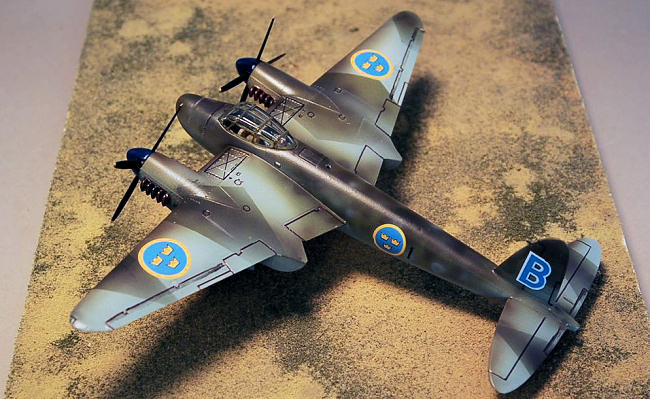
Airfix 1/72 Mosquito NF
| KIT #: | 3062 |
| PRICE: | About $9.00 |
| DECALS: | Three options |
| REVIEWER: | Greg Ewald |
| NOTES: | Interesting subject, old mold |

| HISTORY |
One can not argue the beauty of
the “wooden wonder” of British design…huge engines (Merlins) on top of a super
streamlined shape made for a great all around design. Used as fighters, bombers,
pathfinders, anti-shipping, and finally night attack aircraft,
 the Mosquito performed
admirably in every role. With the advent of American radar advances, the
Mark 13 was continuously upgraded, ending up with a rather ungainly nose
section, but the ability for the intercept officer to locate targets in the
darkest of hours, ending many an Axis bomber’s flight plan!
the Mosquito performed
admirably in every role. With the advent of American radar advances, the
Mark 13 was continuously upgraded, ending up with a rather ungainly nose
section, but the ability for the intercept officer to locate targets in the
darkest of hours, ending many an Axis bomber’s flight plan!
After the threat was dealt with, and the collapse of the Third Reich, many of these magnificent airplanes made their way into foreign service, serving well into the 1950’s. Sweden was a major purchaser of British technology, and ended up with 60 of the refurbished Mk 19’s, labeling them the J30.
| THE KIT |
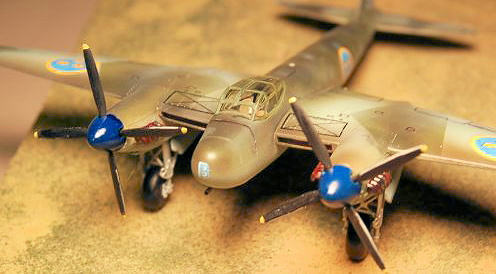 Sadly, the kit as molded is the
same old Airfix offering, with it’s sinkholes, huge numbers imprinted in the
plastic, and somewhat toylike design. The Mk19 parts are contained in a separate
sprue, molded in white plastic.
Sadly, the kit as molded is the
same old Airfix offering, with it’s sinkholes, huge numbers imprinted in the
plastic, and somewhat toylike design. The Mk19 parts are contained in a separate
sprue, molded in white plastic.
The fit of the kit is wonderful, hardly any gap filling is necessary, except for the nose, where you will need to cut away the regular kit nose to fit the radar dome.
The styrene itself is quite nice to work with, not too brittle, and easy to sand. Since this is just a variant of the standard Mosquito kit, you get a lot of spare parts, make sure to clear a spot in your stash. (Editor's note: It seems to me that there was a later molding of the Mosquito that was much better. If that is the case, it is odd that they did not base this kit on the later molding.)
| CONSTRUCTION |
Same as usual, you start with the
cockpit, which in typical small scale fashion, is rather sparse. The pilot
figures are best tossed aside, but the seats are o.k., you may want to add
belts, etc, but remember, this is a closed cockpit, so visibility (at least in
1/1 view) is very limited. When it comes to cutting off the kit nose for the
new radome, it would be best to wait until you have already glued the two halves
of the fuselage together…so make a mark (use a sharpie permanent or the like) as
to where the cut should be made. With the base of the plane put together,
attach the new nose and start the PSR sequence (putty sand repeat) until
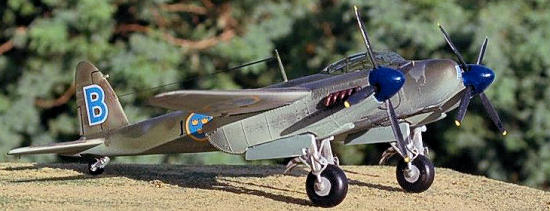 everything is flush, a Dremel tool will really help you out here!
everything is flush, a Dremel tool will really help you out here!
If you want to attach the somewhat primitive rockets and bombs, drill out the necessary holes in the bottom of the wings (parts 25 and 47), but I would heavily recommend using KrystalKlear for the light holes rather than the clunky disks supplied with the kit.
The wing roots have an absolutely fantastic, tight fit, and hardly any lining up was necessary in construction. You can’t say the same about the tail surfaces, unfortunately…glue one on at a time, and check the angles.
The big issue with this kit is
the landing gear assembly. Wow…what a nightmare! You are going to need some C/A
glue, steady fingers, and a lot of quiet time to get these little monsters to
fit together. Eventually (if your kit hasn’t hit the wall or the circular
 recycling bin), you will have the two engine pods assembled and ready to fasten
them to the wings…once again, prepare to be amazed, as the fit is almost
perfect. It did require a small amount of filler on the upper wing to get
everything just so, but nowhere near as much as was expected.
recycling bin), you will have the two engine pods assembled and ready to fasten
them to the wings…once again, prepare to be amazed, as the fit is almost
perfect. It did require a small amount of filler on the upper wing to get
everything just so, but nowhere near as much as was expected.
The under nose piece is meant to house 4 cannon, but I decide to build a Molin’s cannon variant, using a syringe (hey, wife’s a nurse) cut off to replicate the monster…especially after reading that one of these planes blew a J88 in HALF with one well placed round. You have to respect that sort of firepower!
Paint shop, here we come.
| COLORS & MARKINGS |
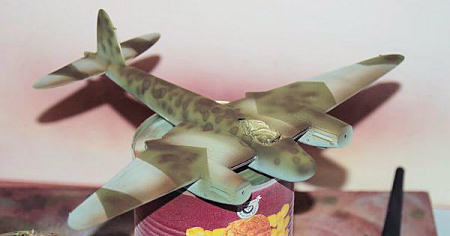 Airfix supplies a really
fantastic color guide, all in Humbrol paint colors (of course)…if you need to
find out what paints you need, you can google a chart.
Airfix supplies a really
fantastic color guide, all in Humbrol paint colors (of course)…if you need to
find out what paints you need, you can google a chart.
I wanted to match my Swedish Mustang with this craft, so I went with an early splinter and mottle job, using a single action with masking tape for the big stuff, and the lovely Hansa double action for the mottling.
The decals were surprisingly brittle (odd for Airfix), and I had quite a lot of cracking and separation during application.
| FINAL CONSTRUCTION |
Many coats of satin erased a lot of sins, and I like the scale effect of satin over flat . The mast was attached, and a long piece of black sprue made for a lovely antennae.
| CONCLUSIONS |
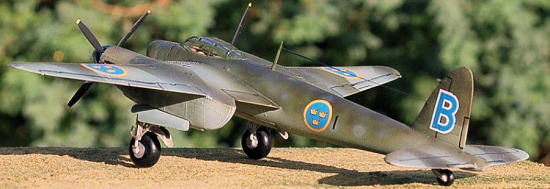 For the money, this was a fun, fun
build. I call it the “Mousquito”, as a friend of mine, John Howling Mouse,
reminded me that building models was supposed to make me happy, instead of
frustrated. Not only did it make for a neat little kit, it helped me get over
the modeling slump I’d been in.
For the money, this was a fun, fun
build. I call it the “Mousquito”, as a friend of mine, John Howling Mouse,
reminded me that building models was supposed to make me happy, instead of
frustrated. Not only did it make for a neat little kit, it helped me get over
the modeling slump I’d been in.
Here’s to good friends, and good models !
Editors Note: I should pass along that the paint scheme is purely spurious. Swedish Mossies were in either RAF camo or Swedish camo and not this very nice, but fanciful scheme.
August 2006
| REFERENCES |
The guns: http://www.quarry.nildram.co.uk/Molins.htm
The plane:http://www.canit.se/~griffon/aviation/text/30mosqit.htm
Copyright ModelingMadness.com. All rights reserved. No reproduction in part or in whole without express permission from the editor.
If you would like your product reviewed fairly and fairly quickly, please contact the editor or see other details in the Note to Contributors.